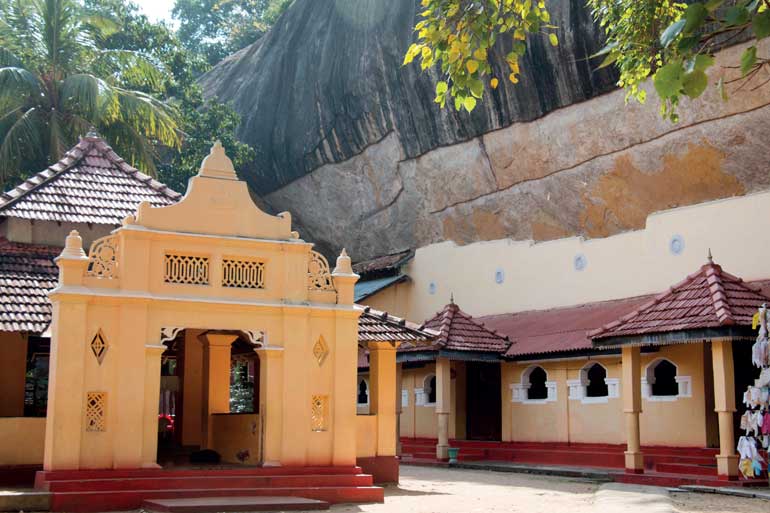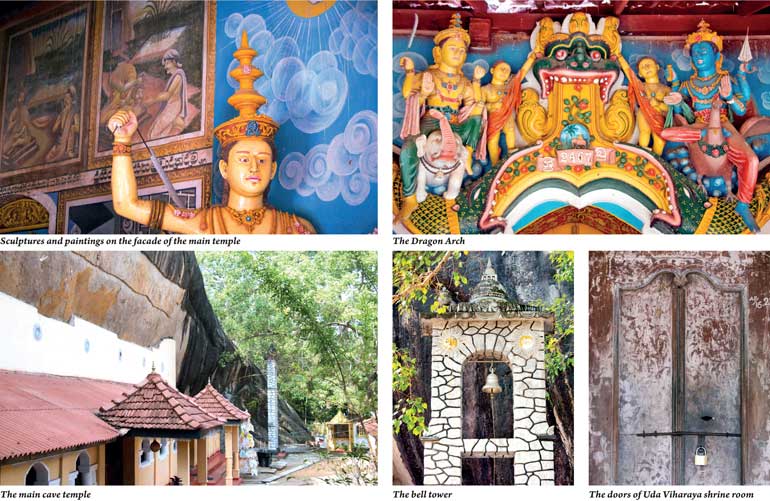Monday Dec 01, 2025
Monday Dec 01, 2025
Saturday, 10 February 2018 00:58 - - {{hitsCtrl.values.hits}}

The original temple is believed to have been built by King Walagamba I during the first half of Anuradhapura Kingdom, but historical evidence suggests that the cave temple might have been used as a monastery for the Buddhist monks during the third century BC. Today, they serve as a Sanghavasa for residing priests
By Aysha Maryam Cassim
Budugehinna Naga Rajamaha Viharaya in Dewahuwa is known as Punchi Dambulu Len Viharaya – so named due to its resemblance to the famous Rangiri Dambulla Cave Temple.
The temple lies 14 km off the Galewela town, bordering Anuradhapura and Matale Districts. As you pass the Galewela-Kalawewa road, closer to the Devahuwa village, a board will direct you to the Punchi Dambulu Len Viharaya. If you are coming from Namal Uyana (Rose Quartz Park), it’s only a short scenic drive to the west that will take less than half an hour. Drive 8km along the country roads until you reach a T-junction at Andiyagala town. Take the turn to your left and continue for about 10 minutes to find the temple site to your right.
As you enter the sacred premises, you’d witness a colossal standing statue of Buddha (Hiti Pilima) in the making. The temple complex consists of a Dagoba, which according to Mahavansa is said to have been constructed by King Devanampiyatissa, one of the earliest rulers who reigned the ancient capital of Anuradhapura from 307 BC to 267 BC. The Chaitya (dagoba) was renovated recently.
The original temple is believed to have been built by King Walagamba I during the first half of Anuradhapura Kingdom. But historical evidence suggests that the cave temple might have been used as a monastery for the Buddhist monks during the third century BC. Today, they serve as a Sanghavasa (residential dwellings for bhikkhus) for the residing priests.
You can walk into the Maha Len Viharaya (Main Cave Temple) through a dragon arch famously known as Makara Thorana. Around the arch, there are vibrant sculptures of Deities, mythical creatures and carvings of floral creepers. The fascinating thing about these caves are the two parallel drip ledges which provided protection to the temple. The drip ledges known as Kataram are about 35m long and on the surface, ancient inscriptions can be found.

In the cave shrine room are a massive sleeping Buddha figure and a fifth-century granite statue of Buddha which was partially destroyed by treasure hunters. A clay head has been added to the original figure in the restoration process.
When you come out of the main cave temple, there is a small stairway that leads to the Uda Viharaya (the upper temple). As the name suggests, this temple is situated on a higher level. Compared to the main cave temple, this is quite small in size. The exterior of the shrine room is adorned with ornate wooden doors and the interior is filled with frescoes of the Kandyan era. But due to poor maintenance and negligence, the frescoes are fading. When closely observed, one could notice that they bear a strong similarity to the paintings in Dambulla Rajamaha Viharaya which belong the school of Nilagama Tradition.
Budugehinna Naga Raja Maha Viharaya is dubbed as Punchi Dambulu Len Viharaya for many reasons. Apart from locals, occasionally only a few people visit this temple. It is not located in the famous Dambulla touristic route and being less familiar to foreigners this temple worth of historic interest is yet to be exposed to outsiders. Next time you take a trip to Dambulla, Kala Wewa, or Anuradhapura, make sure to take a detour along the beaten path and uncover the hidden gems of this cave temple.